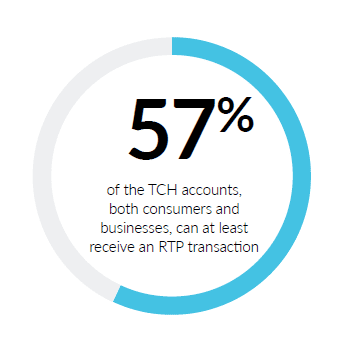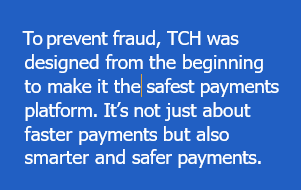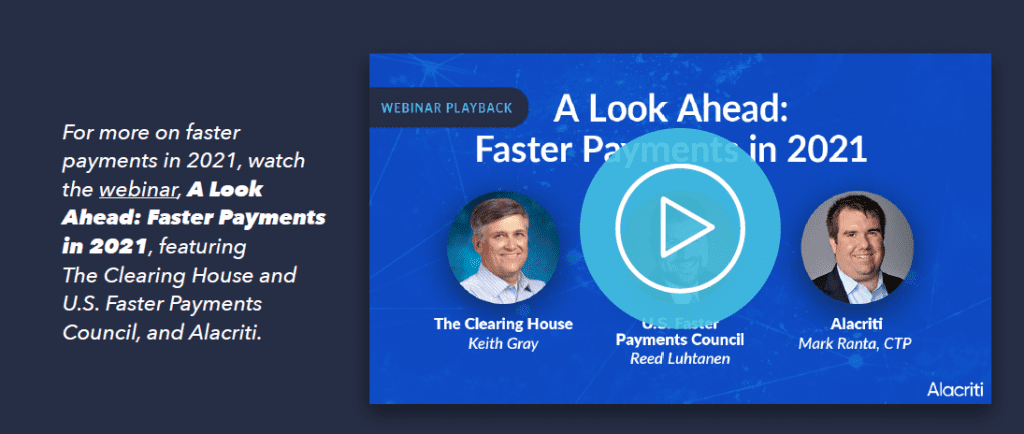Faster payments is an important topic that became even more important in 2020 during the pandemic. In a recent Banking Exchange webinar, Keith Gray, Vice President, Strategic Partnerships, The Clearing House (TCH); Reed Luhtanen, Executive Director, U.S. Faster Payments Council (FPC); and Mark Ranta, Payments Practice Lead, Alacriti, discussed what they expect 2021 to bring when it comes to faster payments.
So, what is a faster payment? According to the Bank for International Settlements’ Committee on Payments and Market Infrastructures:
Traditionally, it has taken a day or more (even weeks in the case of some cross-border transactions) after initiating a cashless retail payment until the funds reached the payee. Frequently, the initiation and processing of transactions has been limited to specific times during the day. These two limitations of traditional payments, payment speed and service availability, are the main features that fast payment initiatives aim to change.
Combined, these improvements provide end users with rapid availability of final funds on a nearly continuous basis and can, therefore, be used to define more formally the concept of “fast payments.” For the purposes of this report, a “fast payment” is defined as a payment in which the transmission of the payment message and the availability of “final” funds to the payee occur in real time or near-real time on as near to a 24-hour and seven-day (24/7) basis as possible
Types of Payments


The U.S. Faster Payments Council and The Clearing House both work to advance the ubiquity of faster payments. FPC is an industry-led member organization whose mission is to facilitate a world-class payment system where Americans can safely and securely pay anyone anywhere at any time with near-immediate funds availability.
FPC members include business end-users, consumer organizations, financial institutions, payment, network operators, technology providers, and others. A little history on the FPC: the Federal Reserve created a Faster Payments Task Force that called upon all stakeholders to realize the vision for a payment system in the United States that is faster, ubiquitous, broadly inclusive, safe, highly secure, and efficient by 2020. The governance framework formation team took the steps of establishing the
U.S. Faster Payments Council in 2018.
“In today’s increasingly mobile digital economy, Americans require a world-class payment system where they can safely and securely pay anyone anywhere at any time.” — Reed Luhtanen, U.S. Faster Payments Council.
Many countries around the world have had government mandates that require the implementation of fast payment services. However, the United States is taking a private sector approach, so there are a number of different solutions in the marketplace with varying capabilities and offerings. The FPC was designed to be
inclusive of all stakeholders. So they include a much broader set of payment systems underneath the faster umbrella. For instance, speeding up existing payments, such as ACH. It’s also worth noting that speed is not the only important element. Any of these new networks which leverage the state-of-the-art ISO 20022 message spec enables a much richer exchange of data between the sender and the receiver.
The Clearing House operates on a core U.S. payments system infrastructure and clears and settles approximately $2 trillion daily, which represents half of all
commercial ACH, wire, and check image exchange volume. TCH started the RTP® network back in 2017. The depository institutions, the banks, and credit unions run on top of the infrastructure TCH provides. They also run a wire transfer network, CHIPS, which is mostly high-value international payments.
About RTP
There are advantages of the network that makes the RTP network different from other payment networks in the U.S (there are about 13 of them). “We call it RTP for a reason, and the advantage of the immediacy of the payment is not just faster, but specifically immediate clearing and settlement — the main thing behind the RTP network” — Keith Gray, VP Strategic Partnerships, The Clearing House. For both consumers and businesses, the RTP network is complete predictability and visibility of the transaction on both ends.
The sender knows the payment has been sent, received, and posted. The receiver also has the same visibility into the transaction — literally within seconds. The average RTP transaction now is taking less than three seconds from beginning to end, and that is complete settlement across the transaction. So it truly is a real-time network, allowing the payer to pay exactly how much they want when they want to pay it.
The challenge of many other payment networks is the lack of visibility, which leaves questions such as: Has it come out of my account? The RTP transaction also carries not only the payment but the data associated with that payment. The information that goes back and forth is referred to as conversational commerce.
Trends and Use Cases
By the end of February, TCH had 100 financial institutions established on the network, with many more than that in the development queue that will be coming live over the next few months. Most of the FIs that are going live today happen through a technology partner relationship like Alacriti. The banks on the network now make up about 50% of the coverage across the DDA base. So 57% of the TCH accounts, both consumers and businesses, can at least receive an RTP transaction.


If you take into account those banks and credit unions, where they have the physical connectivity in place through a company, e.g., a core processor, then that number jumps from 57% to over 70%. These figures continue to escalate as more and more products are coming live on the network.
According to Keith Gray at TCH, millions of transactions clear every month across the network, and that number doubles about every quarter. The momentum of the network escalated, in the midst of the pandemic, as more and more companies and people were looking for a faster way to make and receive payments.
TCH sees a lot of account to account-based activity. For instance, moving money from your main bank account to a credit union account. On average, consumers own 5.3 accounts across all types of financial institutions, so RTP provides a huge advantage. Consumers want to know they can have access to their funds exactly where they want when they want in a matter of seconds.
TCH also sees a lot of gig economy type of volume increase over the last several months. For example, food delivery services companies like GrubHub leverage the RTP network to pay their drivers. At the end of a shift, the driver can immediately see the payment in their account. GrubHub actually actively encouraged drivers to switch to banks that are connected to the RTP network.
TCH is experiencing a growing number of business to business based volume as well. The immediacy of the payment and the data that travels with it is really conducive to corporate types of use cases. For example, the treasurer of a large company can literally manage cash flow down to the second.
For wallet transactions like PayPal and Venmo, when customers move money from their wallet into their bank account, they want it immediately. That’s accomplished by leveraging the RTP network. However, there is a fee associated with this speed of payment, 1% of the value with a $10 cap.
Another application is payroll. Instead of the three-day window required for ACH, some major payroll companies like Paychex use the RTP network for work today, get paid today, payroll. More and more companies in the service industry are moving to this model, and it’s a huge benefit to both employers and employees.
Another trend that TCH has observed is a really dramatic increase in volume is around merchant funding. With sales receipts, a small business owner can access their funds immediately. This is even more important to companies on the weekend. Companies like Alibaba and Square are using the RTP network to increase the level of service they provide merchants by providing them with faster access to their cash. That’s been extremely well-received in that industry, and more and more companies are starting to leverage that capability, especially over the past year, when small businesses have been so cash-pressed.
Faster payments can also improve bill pay. TCH bank participants have gone live with leveraging RTP for bill pay. It has the potential of reinventing the way a bank-based bill pay works for consumers and billers alike. A biller can put a request for payment on the network, and that request can include both the request for the bill payment and the information relating to it. It tremendously improves the user experience, improves the way billers process payments, and makes it work better all around. In addition, payers need not incur a late payment fee when paying bills right when they are due because funds are not immediately credited.
Perhaps the most obvious potential use case is government payments. TCH did over 100 million in ACH payments over the last six or eight months, which involved many checks. If the money had shown up in accounts immediately, it would have been a much better consumer experience.
Network Selection
There are faster payments networks beyond TCH. For instance, speeding up ACH payments to go from multiple day to same day settlement. Same Day ACH has been encouraged by Nacha rules over the last several years, with the most recent rule expanding the Same Day ACH processing window by 2 hours. Since ACH has a ubiquitous reach, Same Day ACH raised the bar for the industry.
There are also card networks and push payment models offered by Visa and MasterCard, and SHAZAM, and several FIs that offer that sort of service for push payments through their proprietary debit networks. Visa Direct and Mastercard Send use original credit transactions in their-real time payment networks that fund from a payor’s credit/debit card to a payee’s card.
The Federal Reserve plans on coming out with the FedNowSM Service, a real-time payments system, in 2023. This will work by debiting and crediting banks’ accounts with the Federal Reserve System. This too will encourage the adoption of faster payments in The U.S.
The selection of networks is a good thing — having just one real-time payments option would lead to less innovation in this space. All of the available networks fill a need, especially when it comes to cross-border transactions and the need to reach across international borders to facilitate transactions. When choosing a network, financial institutions need to consider the most relevant networks to their potential use cases, needs, and the speed they offer. Rather than one network prevailing as best above all others, there will most likely be financial institutions and businesses figuring out which networks serve their needs and work with partners, such as Alacriti, to sort out the best option.
Keith Gray at The Clearing House finds that one of the biggest misconceptions about RTP is that “it is a huge investment or a huge technical lift, to participate on the RTP Network.” He asserts that this is not the case. “One of the things we’ve really worked hard on is our partnerships with the right technology vendors, companies like Alacriti.” Integrating the network’s capabilities or messaging into the back office of the financial institution can be challenging. A partner can help make the onboarding process easy, as well as ensure that you’re able to scale without a huge upfront investment.
Strategy
Figuring out product strategy now is key. Banks and credit unions can typically go live with RTP in a couple of months. Consider questions such as: Do you want to offer services to your businesses? Do you want to update the way the loan process works? Do you want to do business to consumer type products? Have there been indicators that your customers would be interested in faster payments, such as an uptick in Same Day ACH transactions?
Do faster payments mean more fraud? To prevent fraud, TCH was designed from the beginning to make it the safest payments platform. It’s not just about faster payments but also smarter and safer payments. One of the examples of this is making it a credit push model. A lot of fraud on other payment rails comes through the capability of funds pulled out of accounts. RTP doesn’t allow that — the sender has to push the payments — you can’t pull it. Already, banks and credit unions have been making inroads into validating and knowing their customers and their routines. These efforts carry over perfectly to the RTP world. The important thing with RTP is making sure that you’re sending money to the right person and educating the end-user on the importance of doing so. In addition to that, TCH is deploying different types of fraud tools where they can provide information that a bank or credit union can plug into their systems to be able to analyze and improve on the backend. However, considering the volume, TCH has not seen a problem, and it’s been going well so far.


In a perfect world, all organizations would have solutions ISO20022 data rich, built on distributed ledger technology. However, there’s the existing infrastructure that’s 40+ years old to contend with. To kick off your transformation strategy, start by going to the Faster Payments Playbook, a collaboration between Nacha and U.S. Faster Payments Council.
You can also get guidance from TCH’s RTP Network Readiness Checklist, which is based upon what they’ve seen work for participants who are on the network now.
2021
In the webinar, the speakers weighed in on their expectations for 2021. The first thing that comes to mind for Reed Luhtanen at FPC is inclusion. The pandemic has taught us that there is a better way of doing things we were doing in person, and he expected a trend of continuation of that improvement. “And I think there are people who historically haven’t been participating in the formal financial system or in electronic or digital payments or in that digital economy who now see the value of it in a way that maybe they didn’t before.” Keith foresees other use cases for faster payments. For instance, investments accounts where you pay once a month into their brokerage accounts would benefit from instant payments. And it would be even better if it didn’t require them to go into an app every time they want to do it.
Mark Ranta from Alacriti is amazed at the rate of progress when it comes to the modernization of payments. “I’ve seen a lot of data coming out recently on trends that weren’t necessarily new. But what used to take three to five years to happen all happened in about a six-month period. So that break of the trend line accelerated the change that we’d already started to see.”
“I would say the timeline for both consumers and businesses has been accelerated over the past year. Getting paid faster or being able to pay faster has become just an expected way of doing business. And if you can’t get that service from your financial institutions, you could get it from a FinTech or some other third party. We were already moving in that direction as an economy where people expected immediate payments and they expected those payments to be interconnected with different systems or services they use — everything from the Netflixes of the world and Hulus, etc. to the ability to pay those immediately,” Keith Gray, TCH. Of course, there has been more competition in providing these services. Keith expects that a lot of the trends in the way business and payments work that we’re seeing will stay with us in the new normal.
In 2021, TCH plans to expand the capabilities of the network. They will be launching a document service where a small business owner can store an invoice and then link to that invoice within a request for payment. They are also launching tokenization capabilities within the RTP network.
Whatever path you choose, one thing is for sure, payments are getting faster and are the key to payments modernization.












